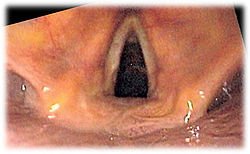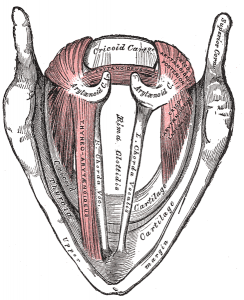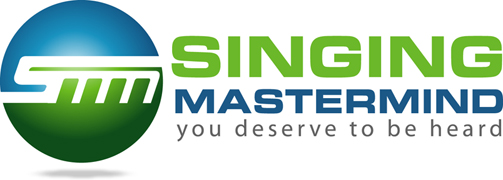Yikes, these really are vocal cords!

Muscles are the key
By knowing where and what to relax and to tense, you will discover how to sing with power, freedom and expressive beauty, especially if you find yourself having trouble going up or down and don’t know what what to do about it. How will you know where to search inside yourself for the answers if you don’t even know what’s going on in there? The answers are about physical muscles, not philosophical or artistic muscles (what are those anyhow?), so get the 411 on anatomy and muscles before you get frustrated or discouraged. I know, I know. Who wants to think about anatomy, right? How can a scientific approach help? I just open my mouth and the best sound in the world just comes out naturally, right? Don’t I wish! That’s not to say that it doesn’t happen that way for some people, but even those fortunate few always benefit from knowing about the muscles they’re using to get such wonderful sounds.

- Pink areas are muscles that help move your vocal cords
Why Know Your Muscles?”
The answer is simple: producing good resonant sound waves requires a fine balance between muscle tension and muscle relaxation of the tongue, cheeks, jaw, mouth, lips and everything other muscle that has a direct or indirect pull on the larynx and pharynx or throat. If there’s undo tension in one, the others are negatively affected. If one is too relaxed, the others try to make up the difference and throw off the balance. And that’s precisely why it is SO important to not only intellectually know what’s going onwith the muscles inside you, it’s also crucial to know how to visualize them in their right locations so that you can literally feel their movements and know which one’s too tight and which one is too loose. Do yourself a favor and take a few minutes to figure out how these drawings apply to you. Do you know where your vocal cords are in your body? Do you know what your larynx is? Can you feel the muscles that surround it? Do you know how to stay relaxed enough in your vocal cord area to make sure your voice isn’t all tied up.
What’s All This Talk About Muscles?
I Just Want To Sing!
I know, I know, but I want to get you thinking about your voice in different ways than the past so that you can sing better in the future. Try to visualize in your body what you seein the images in this article. Try to figure out where they are. If you don’t know and you just can’t visualize them, then stay tuned because I’ll be giving you more and more of this sort of article to help you out.
Visualize Your Muscles
If you can visualize them and begin to be more aware of them inside of you, then you can start relaxing what’s tensing up too much and tightening what’s too loose. You’ll know what is right by whether or not you can feel resonance, those secondary vibrations in your head. One of my best voice teachers told me that you have to train like an athlete to sing well and she was right, so use voice anatomy to rock your world and learn to sing better than you ever imagined you could. Meanwhile, keep singing and remember….
Singing Is Your Joy Released!
Joy Sikorski, Master Voice Trainer


You must log in to post a comment. Log in now.